|
[Front Page] [Features] [Departments] [SGAP Home Page] [Subscribe]

Short Cuts
Readers are invited to submit short items of interest about Australian plants to be included here. If submitting non-original material (eg newspaper or magazine cuttings), please also advise if the author has given permission to republish and, if not, please provide a contact address so that permission can be sought.
Short Cuts in this issue:
 The Ingnitability of Leaves of Australian Plants The Ingnitability of Leaves of Australian Plants
- Information on a new report from the Australian Flora Foundation
 Two Rare New South Wales' Grevilleas Two Rare New South Wales' Grevilleas
- Two relatively recent discoveries from southern New South Wales
 The Leaning Trees of Greenough The Leaning Trees of Greenough
- The answer is blowing in the wind!
 Fireweed...a Spreading Pest of Eastern Australia Fireweed...a Spreading Pest of Eastern Australia
- The exotic daisy, fireweed, is spreading its range
 Mountain Devils Mountain Devils
- ....well-known but rarely cultivated plants in the protea family
 Positive Pavonia Positive Pavonia
- Singing the praises of a misunderstood plant
 
The Ingnitability of Leaves of Australian Plants
A new report on fire tolerance of Australian plants adds some science to the folklaw. But there is still much to learn, as Robyn Corringham reports...
Many lists of fire retarding and fire tolerant plants have been published. They appear regularly after wildfire destruction. It was the 1994 Sydney fires which prompted the Australian Flora Foundation (AFF) to introduce some science into the debate when it asked Dr. A.M. Gill and Peter H.R. Moore of the Plant Industry Division of CSIRO to research the ignitability of leaves of Australian Plants using horticulturally grown species. Most previous research dealt with bushland vegetation though this report is relevant in that area.
Some of us live in fire prone areas and after the good rains of January and February we will hear in September that a bad bushfire season is looming. It behoves gardeners to look closely and act intelligently within our own boundaries.
 |
The fires in January 1994 devastated many areas of New South Wales. Some of the worst fires were in the Blue Mountains to the west of Sydney.
Select the thumbnail image or highlighted name for a higher resolution image (16k).
|
This report offers suggestions and new information. "The hypothesis to be tested was that moisture content and surface area-to-volume control ignition delay time of leaves whether wet or dry." The experiments exposed the leaves to varying high temperatures in a muffle furnace; mineral content, volatile oil content and moisture content in relation to area/volume ratio were recorded.
One may wonder why single leaves only were used. With the endless variables of a plant in its stages of life in its environment with its accompanying horticultural and management practices, leaves provide a more or less common determinator. Live leaves (and cladodes and phyllodes) were selected also because they are often the first organs of a plant to ignite in a fire and their properties are likely to be those of the species rather than the environment. Not forgetting the dead foliage litter underneath the plant.
Some of the results were unexpected. For example, high mineral content tended to decrease ignition delay time and water content need not be a critical factor.
Within a range of 12 seconds to 43 seconds, about half the species leaves ignited below 25 seconds. Using fresh material, Anigozanthos flavidus and Myoporum acuminata have long ignition delay times of 40.05 seconds and 39.48 seconds, respectively. Amyema spp. (mistletoes), which are not really horticulturally popular though fascinating, with moderate moisture levels have a delay time of 38.94 seconds. Among the quickest to ignite were Lasiopetalum macrophyllum, Eucalyptus elata, and Daviesia arborea. Ignition delay time of ten eucalypts varied from 11.57 seconds to 33.22 seconds.
In the Hakea group H.macreana, 35.41 seconds, and H.multilineata, 31.85 seconds, displayed moderate ignition delay times but very low moisture content which contradicts common presumption. H.cristata and H.petiolaris are close to these two. However, H.salicifolia has a high moisture content but a shorter ignition delay time of 15.39 seconds. All is not what it seems, is it?
 |
Hakea multilineata is a spectacular large shrub or small tree which is native to south Western Australia.
Select the thumbnail image or plant name for a higher resolution image (29k).
|
Of course, with oven-dry specimens, the ignition delay time is markedly reduced. Casuarina glauca is slow to ignite when green (43.02 seconds) but when dry takes 10.53 seconds. The ideal would be a long delay factor in the green and in the dry material.
In addition to the experimental findings, the authors recommend avoidance of use of plants which support large proportions of dead twigs (eg. some Melaleuca spp), dead bark (some Eucalyptus spp) or drop copious litter in the local fire season. "Simply removing dead materials will reduce the risk of ignition."
The authors have designed a broad score system which you will find helpful:
KEY
-
If fuel is continuous to the plant in question from the main source of fires (eg. adjacent bushland) then score one point and go (2). If fuel otherwise do not score a point and go to (2).
-
If bark present and flammable add one point and go to (3). If bark not present or nonflammable then do not increase the flammability score and go to (3).
-
If there is a continuity of fuel from the surface to the crown of the plant in question, add one point to the score and go to (4). [Note that this increase can be due to the plant being herbaceous or a short shrub. If there is a lot of litter beneath the plant then the potential flame height can be great and flames could reach the canopy even if it was at a substantial height above the ground; a look-up table could be used to declare 'continuity' according to surface fuel loading and height of the crown base.] If there is no continuity (flames cannot reach the canopy of the plant) do not add to score and end count here.
-
If a canopy is present and has substantial dead material (eg. a cypress hedge, a long-unburnt Xanthorrhoea crown) add one point to the score and go to (6). If a canopy has little or no dead material (eg. because it is deciduous and lost its leaves or is all green), do not add to the score and go to (5).
-
If the canopy is absent (eg. deciduous and lost its leaves or is all green) or sparse, do not add to score and end count. If a canopy is present do not add to the score and go to (6).
- If the ignitability of leaves is high then add one to score and end count. If ignitability is low then do not add to the score and end the count. [You will need to peruse the report to answer (6).]
|
Thus the plant can receive a score up to 5 - its flammability rating. The authors stress the tentative nature of this key and point out the vagueness of its definitions.
When confronted with the elemental power of a wildfire one can't help but wonder how important the seconds are. This study has focused on the plant, not the species, and cumulatively there would be a benefit in using the findings in all their correlations. But there is also advantage in knowing a bit more about what one is doing to the general fire environment in our separate ways.
From the July 1999 issue of the newsletter of the South East NSW District Group of the Australian Plants Society (New South Wales).
For further information on the report contact:
Australian Flora Foundation Inc.
GPO Box 205
SYDNEY, New South Wales, 2001
Australia
[ Return to Index ]

Two Rare New South Wales' Grevilleas
It's a continuing mystery how plants manage to hide from scientific discovery. Gwen Clarke reports on two grevilleas which remained unknown until the 1980s-90s.
Grevillea wilkinsonii - Tumut Grevillea
This plant was first discovered by Mr. Tom Wilkinson in 1991 along the banks of the Goobarragandra River near Tumut in NSW. It is a shrub 1.5-2m high x 2m wide with oblong, toothed foliage. The purplish pink toothbrush flowers appear from late Spring to early Summer.
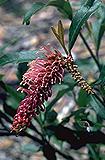 |
Grevillea wilkinsonii is fairly typical of the "toothbrush" flowered group of grevilleas.
Select the thumbnail image or highlighted name for a higher resolution image (37k). Photo: Neil Marriott
|
Geoff Butler, who was then working for the Australian National Botanic Gardens (ANBG) instituted a recovery plan and the SGAP Canberra Region assisted with the implementation of the plan. The site near the road was fully mapped and all plants numbered. Cuttings were taken from these plants and also carefully numbered to match their parents. Plants were then grown by the ANBG and SGAP Canberra for replanting on the site and for distribution to local residents for planting on their properties.
In all, three population have been found along the river. We worked at two of these sites. The responsibility for further work has been handed over to local residents.
In cultivation the plant does very well. A number of plants are growing successfully at the ANBG where they have grown rapidly and are flowering freely. It flowers best in full sun, in neutral to acid soils. It appears that cold conditions are necessary for good bud formation, so it does not flower as well in warmer conditions or at the coast. There are also some plants growing in private gardens here which are also doing well.
Grevillea iaspicula - Wee Jasper Grevillea
This Grevillea grows closer to Canberra than G.wilkinsonii, but SGAP Canberra Region was not involved in the recovery plan.
Grevillea iaspicula was first found in 1980 on a property at Wee Jasper. It grows 1.5-2.5 m high x 1.5-3 m wide with pale green, smooth leaves and well displayed, cream and red flowers for most of the year. It likes well drained acidic (not heavily acidic) to alkaline soils in a sunny position and tolerates heavy frost and dry conditions.
 |
Grevillea iaspicula has a long flowering season and is becoming popular in cultivation.
Select the thumbnail image or highlighted name for a higher resolution image (43k).
|
It does very well in Canberra gardens, where pruning keeps it from becoming leggy. One of our Canberra members has a compact plant. It still grows to 2 m x 2 m but is very dense and appears to have horticultural potential.
From the May 1999 issue of the ASGAP Newsletter.
[ Return to Index ]

The Leaning Trees of Greenough
A group of Eucalyptus camaldulensis growing on the west coast near Geraldton are becoming something of a tourist attraction. David Lang takes up the story....
While there are differences in the extent of lean among the "leaning trees" of Greenough, the typical growth is more or less straight up for about two metres followed by a horseshoe bend until it meets the ground, where its further growth is prostrate. Seeing them, the first question one asks is "what causes it?" Most answers are "the wind", although the NRMA Travel Guide adds another element: "salt-laden winds".
This leaves a lot of questions unanswered: Why do they differ so much from other wind-affected trees and shrubs, for example wind-sheared littoral heathland or trees which have a fairly constant lean from bottom to top or those which lean in their early growth and then curve to a more upright stance. Many of the "leaning trees" seen from the Brand Highway have branches growing straight up from the horizontal trunk. If the winds are strong enough to bend the trunk, why don't they also bend the branches? The species involved, Eucalyptus camaldulensis, is said to be quite salt tolerant, so why do salt-laden winds have such a devastating effect? Many of the leaning trees grow in healthily green pastures, and other trees and shrubs in the vicinity seem little affected by either wind or salt. How can this be if the winds are so salt-laden? These are quite large trees. Where are all the offspring - saplings showing beginnings of the same growth habit? River Red Gums grow mainly along wet and dry water courses and on the plains - why are the specimens seen so far away from any creeks or rivers or plains?
It seems that full answers to these and other questions are not known, but a couple of telephone calls led to some understanding of the situation. A Kings Park, Perth, spokesman said that the growth habit was "genetically fixed". He thought the land in the Greenough area had been cleared in the early to mid - 1880s and estimated the trees to be two or possibly three hundred years old, but he could add nothing more.
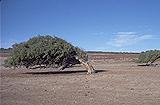 |
Is the bizarre growth of the leaning trees of Greenough genetically fixed?
Select the thumbnail image or highlighted name for a higher resolution image (29k). Photo: Gary Matthews
|
The Greenough Mid West Wildflower Tourist Information and Craft Centre was somewhat more productive. Its spokesman is preparing information about the trees for their Website, aimed at increasing their tourist potential. Here is a summary of what he told me.....
The trees first appeared after the bad 1888 floods. The local clay soil is heavy in salts, including manganese, presumably beyond the species' normal level of tolerance. The prevailing salt-laden winds, plus the salination of the clay soils, cause young trees to start to die from the top when they reach about 2m in height. Many were sheared - "like a crew-cut", he said. Because the salt and wind "burn' one side of the saplings they adapt by bending away from it. So there you go - those who say the wind are right, after all! There are, apparently, saplings in the area which show the beginnings of the same growth habit, although there are now less than 100 fully grown leaning trees. As minor evidence of genetic fixing, he has a sapling at his house which, although not affected by salt or wind, is showing the "leaning tree" growth habit.
You would think that the leaning trees, having a genetically fixed growth habit, would be recognised as a separate variety of the species but, as far as I could ascertain, they are without a variety name. So what further changes might eventuate? Because these trees flower close to the ground (when they do flower), are the pollinators the same as for tall trees? If not, might adaptation to different pollinators result in changes to flower structure? In a couple of hundred years will the variety constitute a different species - E.greenoughii?
From the newsletter of the Warringah Group of the Australian Plants Society (NSW)
[ Return to Index ]

Fireweed; a Spreading Pest of Eastern Australia
Fireweed (Senecio madagascariensis) has become a serious problem in eastern Australia, particularly in New South Wales. Paul Sysum warns of the spread of this pest species into Queensland.
The ASGAP-Weeds Page (Unwelcome Guests) describes fireweed as a south eastern Australia problem (New South Wales). It is something of a problem I know something about as I was employed to remove them at one time in my life.
What really concerns me is that they are not now only a NSW problem but are here in Queensland and spreading rapidly. This is a serious problem and extreme measures should be taken to stop its spread. Once it gets going it is prolific...(25,000 to 30,000 seeds per plant with
almost 100% germination rate), it is worse than the cane toad in production and that is saying a lot.
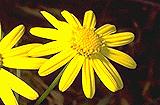 |
The daisy flowers of Senecio madagascariensis may be aesthetically pleasing but the plant is a serious pest species
Select the thumbnail image or highlighted name for a higher resolution image (33k).
|
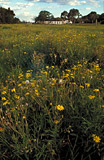 |
An infestation of fireweed, Senecio madagascariensis in the Illawarra Region south of Sydney. The species is a rapidly spreading pest of pastures.
Select the thumbnail image or highlighted name for a higher resolution image (51k).
|
In the southern states it is not as much of a problem as it could be here in Queensland as the temperature is related to germination rates. The higher the temperature, the more the plant flowers and reproduces...so once it gets a foothold here in Queensland.....
Fireweed eliminates all other plant species where it grows, is toxic and can kill animals. A useful site for information is:-
http://www.agric.nsw.gov.au/ap/weeds/publications/p7626.htm
An extract from http://www.drdc.com.au/research/note_45.html.....
Fireweed (Senecio madagascariensis) is a major weed of the coastal plains of NSW and south-eastern Queensland. An exotic from southern Africa, this species has spread widely since its introduction around 1918.
In a survey of farmers from coastal NSW (1996), fireweed was ranked as the worst weed by 43% of dairy, beef and horse producers, and was thought to result in economic losses due to lost pasture production, herbicide use and toxic effects on grazing animals. Fireweed may reduce pasture production on as many as 16% of paddocks on the NSW coast in some years.
From http://www.ento.csiro.au/research/weedmgmt/weedm02.htm......
Fireweed, Senecio madagascariensis, is a toxic yellow flowering plant which competes with useful pastures and is currently occupying most of the New South Wales coastal plains, parts of the Northern Tablelands and Western Slopes and parts of south-east Queensland.
It was assumed to have originated from Madagascar, however a major survey conducted throughout southern Africa found that Australian fireweed most closely matched the fireweed found in Natal. This is the region that will now be surveyed for potential biological control agents pending further funding. Pathogens are likely to be targeted as they are generally more host specific and can be far more devastating in terms of plant death, than many other potential insect biological control agents.
[ Return to Index ]

Mountain Devils
The sight of some unexpected red, tubular-shaped flowers in her garden brought back a flood of memories for Anne Rees.........
Today, as I walked past the garden planted on the cut which was made when our house was built, on our return from an early morning walk the sight of two flowers on our small Lambertia formosa filled me which such delight that I burst out "Yes, yes yes!" much to the amazement of my husband David. We had noticed four buds on the plant some days earlier, but still the sight of the flowers really was exciting.
This garden on the cut was the first one we planted when we moved into our new house two and a half years ago. Most everything else in this garden has really done well, the prostrate grevilleas, "Poorinda Royal Mantle", "Bronze Rambler" and G.gaudichaudii have had to be pruned back as they were encroaching on steps and paths a little too much. Prostrate acacias, A.pravissima and A.baileyana and prostrate banksias, B.serrata and B.integrifolia have spread beautifully, and three plants of Leptospermum polygalifolium "Cardwell' with their lovely pink buds and white flowers have flowered well for the last two years. There are other plants in this garden, some of these are Grevillea lanigera "Mt Tamboritha" form, Banksia "Birthday Candles" and Banksia "Giant Candles", Darwinia citriodora prostrate form, Correa reflexa, Rhodanthe anthemoides and two plants of Melaleuca incana "Velvet Cushion".... all of these have done very well.
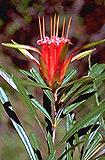 |
The flowers of Lambertia formosa are rich in nectar and attract honey-eating birds.
Select the thumbnail image or highlighted name for a higher resolution image (37k).
|
The Lambertia formosa was a small plant, no more than 20cm high when we put it in, and it didn't seem to put on any growth for such a long time. At one stage we thought that it would die, it did not look good. Then. last year, it seemed to suddenly put on some growth, now it is 85cm high and it has spread to 90cm and it is a very healthy looking plant.
With the flowering of the L.formosa came memories of childhood growing up in an outer northern suburb of Sydney in a house with extensive bushland behind it, where L.formosa grew wild. My sister, brother and I would look for the "Mountain Devil" seed capsules on the plants as we wandered through the bush to the small creek which was a short distance from our back fence. Of course all the houses in our street had gates in the back fences so we could easily reach the bush. Then I remembered the dolls and pipe cleaners that used to be made from the fruits of the Lambertia.
 |
The shape of the fruits of Lambertia formosa clearly indicate the source of the name "devil"....but the plants occur in coastal areas as well as in the mountains.
Select the thumbnail image or highlighted name for a higher resolution image (34k).
|
Other memories came back.....how we used to pick the new leaves of eucalypts and bunches of Ceratopetalum gummiferum (NSW Christrnas bush) to put in vases at Christmas time. (This bushland was not part of a National Park, in due course houses were built all over it much to our disappointment.) Then there was the day I was bitten on the foot by a spider (unknown species) while we were walking through the bush and had to be taken to hospital for treatment. At that time my mother told me that the spider must have bitten me because it became upset after my sister and brother had walked over it, so it bit me as I came along last. I think that she must have told me this in an effort to console me.
So now, with the flowering of the Lambertia, there has come a wish by both David and me to have more of these plants in our garden. David had not seen the plant in flower before (he is a Welshman and he is still discovering Australian native plants). He is very impressed with the beauty of the flowers and also with the fact that the plant is rich in nectar so it will be visited by native birds. I had forgotten how lovely the flowers are so, of course, now I would like more plants.
I would also like to have them in the garden because of the memories that this plant holds for me.
From the March 1999 newsletter of the Australian Plants Society (Victoria).
[ Return to Index ]

Positive Pavonia
Regarded as a weed by many, Pavonia hastata is a plant badly in need of some good "PR". Jeff Howes and Brian Roach sort out the pros and cons.....
To put the following in context.....
In a recent issue of "Blandfordia" (newsletter of the North Shore group of the Australian Plants Society), the editor, Jeff Howes, looked at the virtues of Pavonia hastata and decided that the plant had none. Jeff said.......
Pavonia hastata can grow to two metres and has 5-petalled, 25 mm long and 20 mm wide lilac pink flowers with a red mark at the base and red veins. However the 'hibiscus like' plant is frustrating to grow for many reasons, some of these are:
It is debatable if it is a native at all. In "Native Plants of the Sydney District", Allan Fairley and Philip Moore say "once regarded as a native species, it is now believed to be introduced". However, in "Australian Plants" No.32 dated September 1967, it has this to say "While the genus is centred in South America, it is interesting to note that Pavonia hastata was collected by several of the earlier collectors, e.g. 'Nepean Hawkesbury and Patterson Rivers. R. Brown' ( 1802-5), 'Liverpool Plains. A. Cunningham' ( 1791-1839). On the basis of these early discoveries it is generally regarded as a native of Australia as well as South America."
-
The spring flowers are cleistogamous, that is the calyx opens only when the corolla reduces greatly in size. Practically this means that from early spring buds grow and fatten but form seeds without flowering and it is not until summer that you will get to see the flowers
It seeds prolifically and you are always pulling out seedlings.
Having said all that, why grow them? I did once and I still find seedlings coming up after five years. Is anyone growing this plant and has something positive to say about it?
This attack on a defenceless plant spurred Brian Roach to verse......
I saw beneath the heading
'A Local Plant - Perhaps'
Pavonia hastata
In last month' s news dispatch.
Why did you, Mr Editor
Select that plant at all,
When what you did thereafter
Was to engineer its fall?
You doubted its integrity,
You raised the issue high;
Should we treat it as a native?
Is it really dinky-di?
You even posed the question,
Is there anyone indeed
Who would speak a word in favour
Of this doubtful little weed?
Well, let me be its champion
And proclaim to you its worth:
How this hibiscus look-alike
Needs but a speck of earth.
To flourish by my garbage bins
Where nothing else could last.
Where other plants have come and gone
So often in the past.
But what a sad indictment
In my view, any rate
To bag a plant because its seeds
Are apt to germinate.
So can't we just regard it
As a native plant pro-rata,
And enjoy the many virtues
Of Pavonia hastata.
|
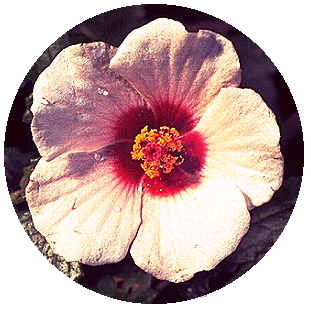
|
From the March and May 1999 issues of "Blandfordia".
[ Return to Index ]

[Front Page] [Features] [Departments] [SGAP Home Page] [Subscribe]
Australian Plants online - September 1999
The Society for Growing Australian Plants
|